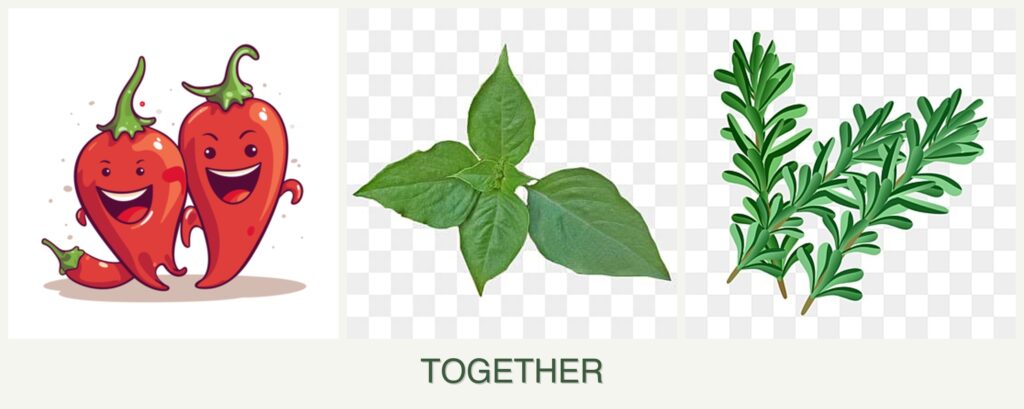
Can you plant peppers, basil and rosemary together?
Can You Plant Peppers, Basil, and Rosemary Together?
Companion planting is a popular gardening technique that involves growing different plants together to enhance growth, deter pests, and improve crop yield. For gardeners looking to plant peppers, basil, and rosemary together, understanding their compatibility is essential. This article provides insights into whether these plants can thrive together and offers practical tips for successful planting.
Compatibility Analysis
Yes, you can plant peppers, basil, and rosemary together, but with some considerations. These plants have differing needs but can complement each other when managed well. Peppers and basil thrive in similar conditions, enjoying full sun and well-drained soil. Rosemary, while more drought-tolerant, can still coexist with these plants if watering is balanced. Key factors include ensuring adequate spacing and managing water requirements to accommodate rosemary’s lower moisture needs.
Growing Requirements Comparison Table
| Plant | Sunlight Needs | Water Requirements | Soil pH | Hardiness Zones | Spacing Requirements | Growth Habit |
|---|---|---|---|---|---|---|
| Peppers | Full sun | Moderate | 6.0-7.0 | 9-11 | 18-24 inches | Upright, 1-3 feet |
| Basil | Full sun | Moderate | 6.0-7.5 | 10-11 | 12-18 inches | Bushy, 1-2 feet |
| Rosemary | Full sun | Low | 6.0-7.0 | 8-10 | 18-24 inches | Woody, 3-4 feet tall |
Benefits of Planting Together
Planting peppers, basil, and rosemary together offers several benefits. Basil is known to repel pests like aphids and mosquitoes, which can protect peppers. It also enhances the flavor of peppers when grown nearby. Rosemary, while not a direct companion for peppers, can deter certain pests with its aromatic properties. Additionally, this combination maximizes space in the garden, allowing for efficient use of resources and potentially improving soil health through diverse root structures.
Potential Challenges
While these plants can be grown together, challenges include competition for nutrients and water, especially since rosemary prefers drier conditions. Peppers and basil require more frequent watering, which can lead to overwatering rosemary if not managed properly. Disease susceptibility, particularly in humid conditions, is another concern. Solutions include using drip irrigation to control water distribution and ensuring proper spacing to promote air circulation.
Planting Tips & Best Practices
- Optimal Spacing: Maintain at least 18 inches between peppers and rosemary to accommodate growth and airflow. Basil can be planted closer to peppers, around 12 inches apart.
- Timing: Plant after the last frost when the soil has warmed up, typically in late spring.
- Container vs. Garden Bed: Containers are suitable for controlling water levels, especially for rosemary. Use well-draining soil and ensure pots have drainage holes.
- Soil Preparation: Enrich the soil with organic matter to improve drainage and nutrient availability. A balanced fertilizer can support plant growth.
- Additional Companions: Consider adding marigolds or onions, which can further deter pests and complement the garden ecosystem.
FAQ Section
-
Can you plant peppers and basil in the same pot?
Yes, they can be planted together in a large pot with good drainage and access to full sun. -
How far apart should peppers and rosemary be planted?
Space them 18-24 inches apart to ensure proper growth and airflow. -
Do peppers and basil need the same amount of water?
Yes, both require moderate watering, unlike rosemary, which needs less frequent watering. -
What should not be planted with peppers?
Avoid planting fennel and kohlrabi near peppers as they can inhibit growth. -
Will rosemary affect the taste of basil or peppers?
No, rosemary will not alter the taste of basil or peppers when grown nearby. -
When is the best time to plant these together?
Plant them in late spring after the danger of frost has passed.
Companion planting peppers, basil, and rosemary can be a rewarding endeavor with careful planning and attention to their individual needs. By understanding their compatibility and managing their growing conditions, you can enjoy a thriving garden that benefits from the collective strengths of these plants.



Leave a Reply